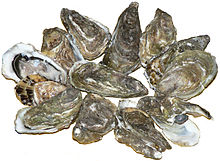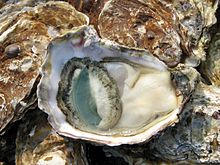Oyster
![]()
This article is about the mussel family. For other meanings of oyster, see oyster.
The oysters (Ostreidae) are a family of bivalves (Bivalvia). The scientific name Ostreidae is derived from the name of the genus Ostrea (plural to Greek ὄστρεον ostreon "shell", "oyster"). Oysters are found around the world on the rocks of shallow tidal waters, but there is also oyster farming.
Oysters have existed for 250 million years, and the number of known fossil species is greater than the number of recent species. Oysters have an important ecological function in coastal waters. They filter around 240 litres of water through their bodies per day to remove nutrients. They also serve as prey for many sea creatures, against which they try to protect themselves with an extraordinarily massive shell.
Oysters are of interest to humans as a foodstuff, although only a few oyster species are considered to be good to eat. These "culinary oysters", whose weight is usually between 50 and 150 g, are given priority in the following. The first specimens were eaten by humans on the Red Sea as early as 125,000 years ago. Other oyster species - called pearl oysters - have the ability to produce pearls. Pearl oysters are found mainly in the Far East. The shells of oysters are also usable.
Systematics
External systematics
Oysters belong to the phylum Mollusca, more precisely to the subphylum Conchifera, and here of course to the class Bivalvia. Together with several other superfamilies, they form the order Ostreida.
Inner systematics
Genres (selection)
The main genera of the oyster family (Ostreidae) are:
- Crassostrea
- Cryptostrea
- Dendostrea
- Lopha
- Magallana
- Ostrea - the most species-rich genus with about 120 known fossil and recent species
- Ostreola
- Saccostrea
- Teskeyostrea
Species (selection)
A selection of the most important species and their world market share in 2003:
| Name | Scientific | Share |
| Pacific oyster | Crassostrea gigas | 93,7 % |
| American oyster | Crassostrea virginica | 5,1 % |
| Hausschuhauster | Crassostrea iredalei | 0,3 % |
| European oyster | Ostrea edulis | 0,2 % |
| Sydney Rock Oyster | Saccostrea glomerata | 0,1 % |
| Mangrove Oyster | Crassostrea rhizophorae | 0,1 % |
| New Zealand Oyster | Ostrea lutaria | < 0,1 % |
| Chilean oyster | Ostrea chilensis | < 0,1 % |
| Gasar-Auster | Crassostrea gasar | < 0,1 % |
| Olympic Oyster | Ostrea conchaphila | < 0,1 % |
| Cortez-Auster | Crassostrea corteziensis | < 0,1 % |
| Cover Oyster | Saccostrea cuccullata | < 0,1 % |
| Indian oyster | Crassostrea madrasensis | < 0,1 % |
| Portuguese oyster | Crassostrea angulata | < 0,1 % |
The Portuguese oyster (Crassostrea angulata) is a problematic species. It is sometimes assumed that it is not a species of its own, but a variety of the Pacific oyster (Crassostrea gigas). However, recent studies suggest that they are two different species after all.

Pacific oysters
.JPG)
Crassostrea gigantissima (Finch, 1824), an extinct species, here a specimen from the Eocene
Anatomy
Tray
The oyster protects itself against its numerous enemies by an exceptionally thick, hard and sharp-edged shell. In the oyster, the two shell valves are not the same. The lower = left shell flap is clearly curved, in it lies the soft body. In the young stage of the oyster, this shell grows on the substrate. It then remains immobile throughout its life. The upper, right half of the shell is rather flat. It serves as a lid and can be opened and closed. When closed, the shell is practically completely watertight. This allows the oyster to survive up to two weeks out of water without drying out.
The shells consist mainly of calcium carbonate. However, pure lime does not have the breaking strength necessary to defend against enemies. The oyster therefore builds the shell from two substances: The calcium carbonate crystals and a substance called conchin (also: conchiolin). This organic mixture of proteins has the task of sticking the calcium carbonate crystals together. In this way, a very break- and shock-resistant shell is created.
The shell has a three-layer structure. The outermost layer, exposed to the environment (periostracum), has a particularly high strength. Depending on the exact chemical composition, it has different colours (grey, brownish or greenish). Within this shell follows a thin, chalk-like layer (ostracum) of tiny calcite crystals. Finally, the innermost layer is the nacreous layer (hypostracum), which consists of aragonite. It is more elastic than the outer layers and prevents the propagation of cracks in the shell.
The two halves of the shell are connected by a hinge (ligament). In elongated oysters, it is located on the tapering side of the shell. The hinge is constructed so that the shell is open when not under force; closing it requires an effort on the part of the bivalve. Within the hinge is found a rubbery layer (resilium) that is squeezed when the shell is closed. If the mussel relaxes the sphincter, the resilium pushes the two shell halves apart again.
Soft body
The soft body is entirely embedded in a thin "mantle", which has only openings for water intake and digestion. When the oyster is open, the mantle can be seen as the outermost lobe near the edge; it is sometimes called the "beard". The lobe of the mantle regulates the inflow of water to the gills. In addition, it serves as a sensor: when touched, it triggers the immediate closing of the shell.
The mantle also provides the structure of the shell. The mantle contains special cells called epithelial cells, which are able to secrete calcium carbonate and conchin. Depending on the mixing ratio of these two substances, the mantle can produce the different layers of the shell. The epithelial cells at the edge of the mantle lobes build the two outer layers (periostracum and ostracum) of the shell. The inner parts of the mantle take care of the growth of the pearly layer (hypostracum). Those parts of the mantle that are close to the hinge supply the ligament with a special conchin mixture and keep it functional at all times.
The ability to form a layer of nacre is also used by the mantle to combat intruders. If organic or inorganic substances get into the oyster, the epithelial cells immediately cover them with a layer of nacre and thus render them harmless. Only in very special oyster species does this process produce a large, spherical pearl. In culinary oysters, this pearl formation is extremely rare. If a pearl does form, it is hardly ever larger than one to two millimetres, it is unsightly and worthless. Such small pearls are not usually noticed when "slurping". It is virtually impossible to discover a valuable pearl when opening a culinary oyster.
Organs
The largest organ of the oyster in terms of area are the gills. They have a dual function: firstly, they serve for respiration by absorbing oxygen from the water and transferring it into the bloodstream. Secondly, the gills serve to absorb food. They are covered with countless tiny hairs (cilia) that move quickly and feed plankton - mainly microscopic algae - to the gills. The water flow rate is extraordinarily high: the oyster passes up to 240 litres of water through its body per day. The gills contain mucus glands that stick the tiny food particles together. These small packages of mucus are then transported further towards the mouth by two pairs of muscles.
The mouth of the oyster has an antechamber in which indigestible substances are excreted. The mouth also regulates the amount of food that is fed to further digestion.
Finally, the food reaches the stomach, where it is stirred by a mobile, sharp-edged "crystal". Enzymes then convert the food into the body's own substances. Indigestible food is transported into the relatively long, tortuous intestine and expelled from there via the rectum and anus.
Immediately next to the sphincter (towards the hinge) is the heart of the oyster. It has two chambers (atrium and ventricle) and pumps the milky blood of the oyster through the body.
Next to the heart is the sexual organ, the gonads. The oyster is hermaphroditic, so the sex organ can alternately produce sperm or eggs. (For more details, see "Reproduction").
The most powerful part of the oyster's body is the sphincter, which can account for up to 40 percent of the body mass. The sphincter penetrates the soft body vertically and is anchored to both the upper and lower half of the shell. It is exceptionally strong - it is not possible to open a healthy oyster without the aid of a tool. The muscle consists of two types of tissue. Some strands of muscle are capable of closing the shell at lightning speed in the event of danger. The other strands are designed for endurance; they can keep the shell closed for days and weeks. The sphincter can only close the shell, but not open it - this is accomplished by the hinge (ligament).
Unlike other bivalves, the adult oyster has no foot, it is not capable of any kind of locomotion. With the exception of simple pressure sensors, oysters have no sensory organs, they have no brain and only rudimentary rudiments of a nervous system. They are therefore not consciously aware of their environment.

Pacific oyster, open

Pacific oyster from Marennes-Oléron
Questions and Answers
Q: What is an oyster?
A: An oyster is a type of bivalve with a thick, rough shell from the family Ostreidae. Some other types of shellfish are also called 'oysters'. Many species are edible and usually served raw or cooked.
Q: How were oysters used in the past?
A: In the past, oysters were an important food source, especially in France and Britain. They grew in huge beds but were overfished during the 19th century.
Q: Are oysters harvested when they are fully grown?
A: No, oysters are usually harvested before they reach full size. If left to themselves, they can grow quite large - for example one was 11 inches long (29cm) and 3.7 lbs in weight (1.7kg). The world's largest recorded oyster was 13.97 inches long (35.5cm) and 4.21 inches (10.7cm) wide found in Denmark in December 2013 according to Guinness World Records.
Q: How are oysters harvested?
A: Oysters are picked up from their muddy beds by dredging them out of the water with special tools or nets designed for this purpose.
Q: How do you shuck an oyster?
A: Shucking is done with a short knife inserted between the upper and lower shells of an opened-up oyster until there is a slight pop sound as it breaks open; then slide the blade upward to cut away the adductor muscle which holds it closed so that it releases from its shell before sale or consumption..
Q: Does seawater stay inside an opened up oyster?
A: No, any seawater inside an opened up oyster does not stay there as all shellfish generally undergo purification while still alive after harvesting by being placed into tanks pumped with clean water for 48 to 72 hours before sale or consumption to protect consumers from any foul bacteria that may have been picked up from sea or river water sources where they were found originally..
Q: Are pearl clams related to true osyters?
A:No, pearl clams belong to a different species called Pinctada which looks similar when taken out of its shell but is not related to true osyters belonging to Ostreidae family
Search within the encyclopedia